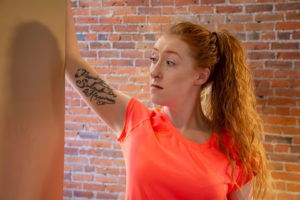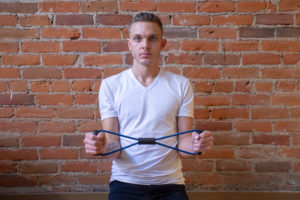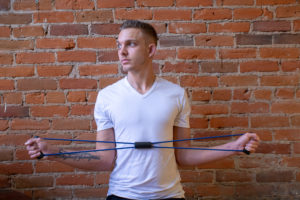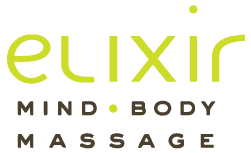Five Simple Stretches to Improve Your Posture
Why does our posture play such a big role in pain? This question can be answered with two words: tension and compression. A muscle that is constantly stretched can build up adhesions between muscles and fascia, called trigger points, to provide stability and keep the muscles from tearing. Imagine the space between your shoulder blades, or the tops of your shoulders, those small nodules in the tissue that feel almost like rocks are constantly stretched as your shoulders round in. Long periods of compression similarly cause soreness, such as in the neck or lower back, where the spine curves inwards.Every muscle group in the body has what we call an ‘antagonist’ or opposing counterpart, required for postural balance. When one area is stretched, its antagonist will be compressed and vice versa. The brain naturally relaxes opposing muscles when their antagonist muscle contracts, a process called reciprocal inhibition; without which, no motion would occur.
In order to fully address postural imbalances, it is important to integrate strengthening exercises for those over stretched muscles in addition to massage, which is great for releasing trigger points, increasing range of motion, breaking up fascia , lengthening tissues and increasing blood flow.
For those that regularly work at a computer or with their hands stretched out front, a simple pattern of tension and compression often exists within the body. The mid-back and shoulders are under frequent tension while the neck and back are being compressed. The shoulders rounded and stretched forward compressing the upper chest.
The goal is to oppose the forces acting on each area: stretch and massage to lengthen compressed areas and strengthen weak muscles to balance the opposing tension. By including these five activities with the Elixir Exercise Band you can increase the benefits you receive from your regular massage and ultimately improve your posture and strength while decreasing your pain.
Before performing this or any sequence of stretches or exercises, be sure to note your limitations and be aware of the following practical precautions:
Neutral/Resting position should be a comfortable and relaxed posture, with the shoulders rolled back and down and the eyes facing front. This position is where you should begin all your exercises and return to this position after every set.
Avoid ballistic stretching – ballistic stretching involves performing a stretch with a bouncing movement, which can cause strain or injury; especially if muscles have not been properly warmed up.
Avoid rolling your head from one side to the other while facing upwards, as this can cause spinal injuries.
Always consult your physician before engaging in any new exercise or stretching regimen.
-
Warm Up Circles
Goal: Increase blood flow in the neck and shoulder girdle to prepare for stretches and exercises.
Muscles : Scalenes, Sternocleidomastoid, Pectoralis Major, Pectoralis Minor, Subscapularis Infraspinatus, Rhomboids Major and Minor, Teres Minor, Trapezius, Rhomboids Major and Minor, Latissimus Dorsi, Posterior Deltoid, Biceps Brachii and Brachialis.
Technique: Begin in a comfortable resting position and extend arms out to either side with palms facing up. Perform 10-15 seconds of arm circles, both forward and backwards. Next, gently rotate the head from side to side in a half moon shape. Finish by bringing the chin to the chest, placing the hands at the base of the skull and gently tractioning downward into the chest.

-
“Opening up” – Posterior and Lateral Neck stretch
Goal: Stretch the muscles in the front and sides of the neck, improving forward head posture and elevated shoulders, reduce compression in the chest and neck.
Muscles: Scalenes, Sternocleidomastoid, Upper Trapezius
Technique: Begin in a resting position and place one arm behind the back and let the forearm rest, this helps to keep the shoulder stationary during the stretch. Keeping your eyes to the front, gently tilt your head in the opposite direction to bring your ear to your shoulder and hold for 3 deep breaths, feeling the tissue relax on each full exhale. Next, gently tilt your chin upwards towards the ceiling and take a few more breaths. Return to your resting position and then repeat on the opposite side.


-
Doorway Stretch- Pectoralis Major and Minor
Goal: Create length in the upper chest and movement in the shoulder girdle, allowing the shoulders to hang properly along the midline. This stretch also opens the chest for a full range of motion in the next exercises. The Pec Major muscle moves the arm, while Pec Minor actually acts on the front of the shoulder blade- for many a compressed Pec Minor could be a cause for pain throughout the body.
Muscles Stretched: Pectoralis Major, Pectoralis Minor, Subscapularis and more.
Techniques: one may feel tighter than the other.
Pec Major.: Stand inside a door frame with one arm horizontal and forearm vertical, with palm and elbow on the wall. Squeeze your shoulder blades together to activate the reciprocal inhibition, then lean through the doorway until you feel a comfortable stretch. Hold this position for three deep breaths, then repeat on the other side.
Pec Minor.: In the same door frame, reach your arm about 45 degrees up from horizontal, or as high as you can while keeping your palm and elbow on the door frame. Squeeze your shoulder blades together and down, then lean through the doorway until you feel a comfortable stretch, for three breaths, then repeat on the other side.


-
Double Doors- External Rotation Exercise
Goal: Strengthen and tighten the shoulder muscles we use the least. Improve shoulder posture and back pain, by releasing tight chest muscles through reciprocal inhibition.
Muscles: Infraspinatus, Rhomboids Major and Minor, Posterior Deltoid, Teres Minor,
Technique: Hold the Elixir Exercise Band out in front of you, one handle in each hand. Keep your arms tightly to your sides, it may help to hold a towel to your ribs with your elbow. Pull the handles away from each other, rotating outward at the shoulder. Using a smooth, controlled motion, return to the starting position by rotating the shoulder inward.


-
Rowing Exercise- Scapular Retraction Exercise
Goal: Strengthen the muscles which retract and stabilize the shoulder blades. Counteract the tension coming from tight Pectoralis muscles.
Muscles: Trapezius, Rhomboids Major and Minor, Latissimus Dorsi, Posterior Deltoid, Biceps Brachii and Brachialis.
Technique: Anchor the middle of the Elixir Exercise Band around a strong post or door knob. Begin with one handle in each hand and your elbows at your side. Squeeze your shoulder blades together and pull your arms behind your mid-line as far as you can. Return to the starting position with controlled movement. Keep your core tight throughout the movement and avoid using the extension of your back to pull the band.



